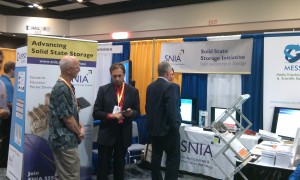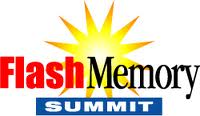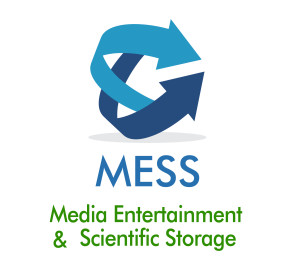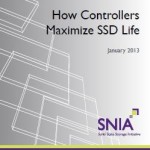If you attended Flash Memory Summit along with thousands of other business professionals, you soon learned that solid state keynotes, breakouts, and show floor booths, while informative, could be mystifying. Fortunately, the SNIA Solid State Storage Initiative (SSSI) was at FMS to provide enlightenment in the form of a SSS Reception, four new publications on SSS, and three SSSI member demonstrations.
SSSI’s second annual SSS Reception was attended by over 90 individual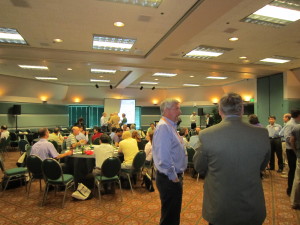 s and featured presentations by SSSI Governing Board members Paul Wassenberg of Marvell, Walt Hubis of Fusion-io, and Eden Kim of Calypso Systems on SSSI key programs and technical work. SSSI Education Chair Tom Coughlin of Coughlin Associates delivered a market update on ubiquitous flash memory. All SSSI members are eligible and encouraged to join specification development, education, and outreach programs, and new companies are welcome to join SSSI activities.
s and featured presentations by SSSI Governing Board members Paul Wassenberg of Marvell, Walt Hubis of Fusion-io, and Eden Kim of Calypso Systems on SSSI key programs and technical work. SSSI Education Chair Tom Coughlin of Coughlin Associates delivered a market update on ubiquitous flash memory. All SSSI members are eligible and encouraged to join specification development, education, and outreach programs, and new companies are welcome to join SSSI activities.
At the SSSI Booth, attendees snapped up new white papers and Tech Notes authored by SSSI members. These papers are complimentary to all interested individuals and available on the SSSI education page.
- The PCI Express (PCIe) 101 – An Overview of Standards, Markets, and Performance white paper surveys the broad landscape of emerging high performance PCIe storage and the implications of revolutionary applications of these new architectures. Thirteen members of the SNIA SSSI PCIe SSD Committee representing eleven SNIA and SSSI member companies contributed their technical expertise to this paper, which covers standards, programming models for non-volatile memory, the PCIe SSD market, and PCIe SSD performance.
- The SSD Performance – A Primer white paper, authored by SNIA SSS Technical Work Group chair Eden Kim of Calypso Systems, provides an introduction to solid state drive performance, evaluation, and test. As noted in the Foreword by SSSI Founder and 2008-2010 SSSI Chair Phil Mills of IBM, “this paper is an excellent tutorial on the performance of solid state drives, which covers this topic in a very easy to understand way, yet provides detailed technical information that the reader can either dig into for a better understanding, or simply skip without missing the main points”.
- A new PTS User Guide Tech Note delivers the hows and whys of the SNIA Solid State Performance Test Specification. Authored by SNIA SSSI members Eden Kim of Calypso Systems and Chuck Paradon of HP, this Tech Note provides an easy to understand, step-by step guide to using the SNIA SSS Performance Test Specification (PTS) test methodologies and tests. The Tech Note discusses four basic PTS 1.1 tests – Write Saturation (WSAT), IOPS, Throughput (TP) and Response Time (or Latency) – as updated per SNIA draft PTS-E version 1.1.
- The SSSI Workload I/O Capture Program (WIOCP) FAQ, authored by SNIA SSSI member Tom West of hyperI/O LLC, gives details on this project undertaken by the SNIA SSSI to collect I/O operation performance metrics. These empirical metrics reflect the actual I/O operation activity performed during normal, everyday application/workload usage spanning both consumer/client and enterprise systems.
Also in the booth, the Media, Entertainment and Scientific Storage (MESS) Meetup group chatted with end users, and SSSI members exhibited new solid state storage solutions for enterprise markets:
- BitMicro presented a high performance MaxIO drive incorporating BiTMICRO’s ultra fast Talino Quad Core ASIC controller, which integrates embedded processors with a high speed multi-bus design to achieve performance far beyond legacy solid state designs.
- Fastor Systems unveiled a NVMe compliant PCIe software defined storage device (SDS), or post-controller SSD, in which a de-coupled control & data plane together with a non-blocking fabric and message based architecture provide both high throughput and low latency to address the needs of today’s hyperscale datacenters.
- Micron showcased a P420m PCIe SSD featuring multilevel (MLC) NAND technology.
